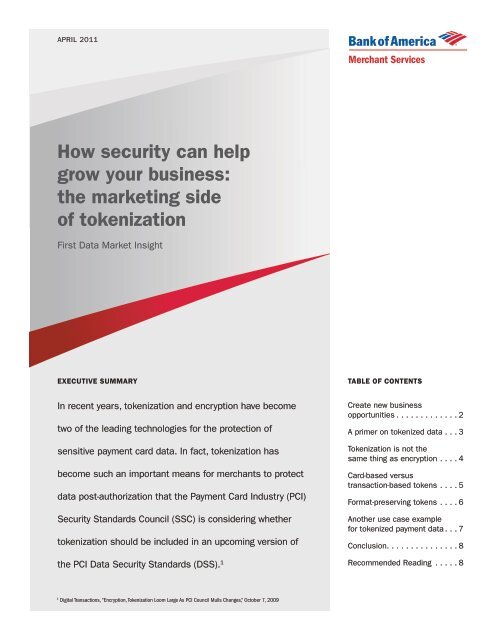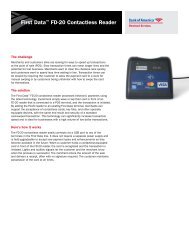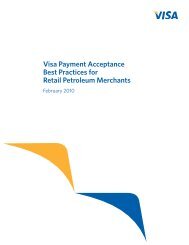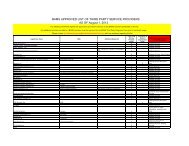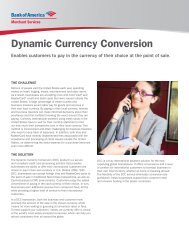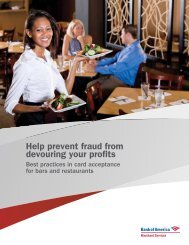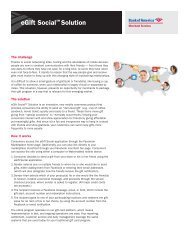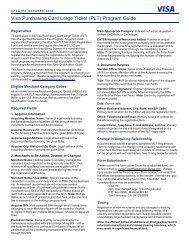How security can help grow your business the marketing side of tokenization
How security can help grow your business: the marketing side of ...
How security can help grow your business: the marketing side of ...
- No tags were found...
Create successful ePaper yourself
Turn your PDF publications into a flip-book with our unique Google optimized e-Paper software.
<strong>How</strong> Security Can Help Grow Your Business: The Marketing Side <strong>of</strong> Tokenization 2Many merchants are not waiting for <strong>tokenization</strong> to be mandated; <strong>the</strong>y are using<strong>the</strong> technology now to vastly reduce <strong>the</strong> risk <strong>of</strong> a data breach as well as <strong>the</strong>scope and cost <strong>of</strong> <strong>the</strong>ir PCI <strong>security</strong> audits. But along with <strong>the</strong> <strong>security</strong> benefits,<strong>the</strong>se companies have discovered an additional <strong>business</strong> advantage. Tokenizedpayment data opens up numerous possibilities, especially for those companiesthat have not previously kept transaction data after <strong>the</strong> authorization andsettlement processes.What kind <strong>of</strong> possibilities? Non-sensitive tokenized data <strong>can</strong> be used in back-end<strong>business</strong> operations to develop innovative <strong>marketing</strong> campaigns, create customerloyalty programs, conduct <strong>business</strong> data analysis, and even assist with lossprevention. These types <strong>of</strong> value-add applications enhance <strong>the</strong> overall <strong>business</strong>case for a merchant to implement a <strong>tokenization</strong> solution. By substituting tokensfor Primary Account Numbers (PANs), <strong>the</strong> merchant is now able to perform newfunctions without risking <strong>the</strong> exposure <strong>of</strong> real cardholder data.Create new <strong>business</strong> opportunitiesNon-sensitive tokenizeddata <strong>can</strong> be used in backend<strong>business</strong> operationsto develop innovative<strong>marketing</strong> campaigns,create customer loyaltyprograms, conduct <strong>business</strong>data analysis, and evenassist with loss prevention.The best way to visualize this kind <strong>of</strong> new <strong>business</strong> opportunity is with anexample. Con<strong>side</strong>r <strong>the</strong> case <strong>of</strong> a quick-service restaurant (QSR). The <strong>business</strong>accepts credit and debit cards from its customers, who typically make purchasesin amounts less than $25.In <strong>the</strong> old <strong>business</strong> model, <strong>the</strong> restaurant does not keep information related to<strong>the</strong> payment cards beyond <strong>the</strong> settlement process because <strong>the</strong>re is little need toretain this data in a QSR <strong>business</strong>. If <strong>the</strong> restaurant must handle a chargebackor return — a relatively uncommon occurrence for QSRs — <strong>the</strong> transaction iscompleted in cash. Unfortunately, in this traditional model <strong>the</strong>re is no method fortracking or analyzing a customer’s behavior over time, because nothing has beencaptured to act as a reference to associate transactions with that customer. Once<strong>the</strong> customer receives his food and walks or drives away from <strong>the</strong> point-<strong>of</strong>-sale(POS), <strong>the</strong> opportunity to learn more about his habits and preferences is gone.In <strong>the</strong> new <strong>business</strong> model — one in which <strong>the</strong> QSR receives tokenized data fromits payments processor after authorization — <strong>the</strong>re is now a permanent and safereference number to tie back to that specific customer. The QSR <strong>can</strong> analyze<strong>the</strong> transaction data to understand more about <strong>the</strong> customer, such as whichlocation(s) he dines at, what time <strong>of</strong> day he frequents <strong>the</strong> <strong>business</strong>, what hepurchases, and so on.The company could turn information about customer buying behavior intotargeted POS promotions, such as a discount coupon for a future visit printedon <strong>the</strong> sales receipt after <strong>the</strong> customer has visited <strong>the</strong> restaurant “x” number
<strong>How</strong> Security Can Help Grow Your Business: The Marketing Side <strong>of</strong> Tokenization 3<strong>of</strong> times. Or, <strong>the</strong> data could be used to support a loyalty rewards programfor frequent customers without having to issue a separate loyalty card. Theadvantage here is that loyalty programs increase annual same store sales anaverage <strong>of</strong> 4 percent. 2 This is not surprising; when given a choice between arestaurant with a loyalty program and one without, more than 60 percent <strong>of</strong>consumers will choose <strong>the</strong> restaurant with <strong>the</strong> loyalty program. 3A primer on tokenized dataNow that we have established that operational processes enabled by<strong>tokenization</strong> <strong>can</strong> <strong>help</strong> <strong>grow</strong> a <strong>business</strong>, it may be <strong>help</strong>ful to provide a moredetailed explanation <strong>of</strong> <strong>tokenization</strong>. What is it? Who manages <strong>the</strong> process?<strong>How</strong> does it fit into a company’s <strong>business</strong> operations?In general terms, <strong>tokenization</strong> is <strong>the</strong> process <strong>of</strong> creating a string <strong>of</strong> randomcharacters called a token (or alias) that acts as a substitute for real data. Often,<strong>the</strong> original data is too sensitive or valuable to thieves to be maintained foranalysis as-is. The data could be cardholder account numbers, personal healthinformation, social <strong>security</strong> numbers, or a variety <strong>of</strong> o<strong>the</strong>r types <strong>of</strong> informationthat must be protected from possible exposure or <strong>the</strong>ft.In <strong>the</strong> merchant world, <strong>the</strong> sensitive data is usually <strong>the</strong> account numberassociated with a customer’s payment card. The process <strong>of</strong> tokenizing thisdata is <strong>of</strong>ten built into <strong>the</strong> payment authorization process and managed by <strong>the</strong>merchant’s acquirer or processor. When using a service-based <strong>tokenization</strong>model, <strong>the</strong>re is no equipment for <strong>the</strong> merchant to buy or install. When apayment card is used in a transaction, <strong>the</strong> authorization takes place as usual.Once authorized, <strong>the</strong> actual PAN is sent to a centralized and highly secureserver called a “vault” where it is stored by <strong>the</strong> payment processor. An indextable in <strong>the</strong> vault creates a permanent relationship between ei<strong>the</strong>r <strong>the</strong> cardnumber or <strong>the</strong> transaction number and a token. Immediately after <strong>the</strong> PANis tokenized, <strong>the</strong> desensitized substitute number (token) is returned to <strong>the</strong>merchant’s systems for use in place <strong>of</strong> <strong>the</strong> PAN, which is no longer needed afterauthorization. The process is shown on <strong>the</strong> next page in Figure 1. The end resultis that <strong>the</strong> token <strong>can</strong> be used in various <strong>business</strong> applications as a safe andreliable substitute for <strong>the</strong> real PAN.In general terms,<strong>tokenization</strong> is <strong>the</strong> process<strong>of</strong> creating a string <strong>of</strong>random characters called atoken (or alias) that acts asa substitute for real data.2Chockstone, Inc., http://www.chockstone.com/products/loyalty3Chockstone, Inc., http://www.chockstone.com/markets/restaurants
<strong>How</strong> Security Can Help Grow Your Business: The Marketing Side <strong>of</strong> Tokenization 4Tokenization is not <strong>the</strong> same thing as encryptionFigure 1: Tokenizing data as part <strong>of</strong> <strong>the</strong> payments processConsumerMerchantAquire/Processor(Merchant’s bank)AuthorizationMerchant’sBackenddatabaseRepresents encrypted dataRepresents tokenized dataCardholder datain secure vaultOn <strong>the</strong> surface this may sound like encryption, but it is not; <strong>the</strong>re is an importantdifference between encrypted numbers and tokenized numbers.Encryption involves <strong>the</strong> application <strong>of</strong> a ma<strong>the</strong>matical process to <strong>the</strong> datato render it unintelligible or unusable. Encryption is distinguished by beingrepeatable, reversible, or both. There is a direct ma<strong>the</strong>matical relationshipbetween <strong>the</strong> original and <strong>the</strong> derived value, called ciphertext. Although secure,it is possible to regenerate <strong>the</strong> original value if someone has <strong>the</strong> “key”— <strong>the</strong>algorithm that reverses <strong>the</strong> encryption process. Therefore, it is very importantto protect <strong>the</strong> key that <strong>can</strong> decrypt <strong>the</strong> data. Key management <strong>can</strong> be quite acomplex process. The data encryption process is illustrated in Figure 2 below.Figure 2: The data encryption processData EncryptionEncryption involves<strong>the</strong> application <strong>of</strong> ama<strong>the</strong>matical processto <strong>the</strong> data to render itunintelligible or unusable.Encryption is distinguishedby being repeatable,reversible, or both.Card data in plain textAlgorithmCiphertextIn contrast, <strong>the</strong> association between a token number and <strong>the</strong> original value ismaintained in an index database (<strong>the</strong> vault), and <strong>the</strong>re is no direct ma<strong>the</strong>maticalrelationship between <strong>the</strong> original value and <strong>the</strong> resulting token. There is no keythat <strong>can</strong> reverse <strong>the</strong> process to turn <strong>the</strong> token back into meaningful data. Atoken is simply a random string <strong>of</strong> characters. The only way to regenerate <strong>the</strong>original data from <strong>the</strong> token is to reach into <strong>the</strong> highly secured vault and use <strong>the</strong>
<strong>How</strong> Security Can Help Grow Your Business: The Marketing Side <strong>of</strong> Tokenization 5index to relate <strong>the</strong> token to <strong>the</strong> card data. This is virtually impossible for thievesto do. See figure 3 below for an illustration.Figure 3: The Tokenization processTokenized ProcessCard dataTokenized numberSecure token vault with linkbetween card and token numbersTechnically speaking, encrypted numbers could work as substitute values for realcard numbers in backend <strong>business</strong> applications. <strong>How</strong>ever, key maintenance and<strong>the</strong> process <strong>of</strong> encrypting and decrypting <strong>the</strong> data would be so cumbersome asto make <strong>the</strong> applications impractical. What’s more, using encrypted data meansthat <strong>the</strong>se applications are still a part <strong>of</strong> <strong>the</strong> cardholder data environment (CDE)that is subject to PCI compliance and audits. Since token numbers are not ableto be tied back to <strong>the</strong> original PAN, <strong>the</strong>y do not pose such problems, makingtokenized data ideal for use in <strong>business</strong> applications.Encrypted numbers couldwork as substitute valuesfor real card numbersin backend <strong>business</strong>applications.Card-based versus transaction-based tokensAs mentioned earlier, unique tokens <strong>can</strong> be generated in one <strong>of</strong> two ways: by <strong>the</strong>card, or by <strong>the</strong> transaction.In <strong>the</strong> case <strong>of</strong> a card-based token, <strong>the</strong>re is a life-long relationship between a PANand a tokenized number. Every time a consumer uses his card at a merchant’sstore, <strong>the</strong> same token number is extracted from <strong>the</strong> vault and provided backto <strong>the</strong> merchant in <strong>the</strong> authorization response. (This assumes <strong>the</strong> paymentprocessor is <strong>the</strong> creator/keeper <strong>of</strong> <strong>the</strong> tokens.)There is a life-longrelationship between a PANand a tokenized number.The advantage <strong>of</strong> a card-based token is that <strong>the</strong> merchant <strong>can</strong> tie toge<strong>the</strong>r aconsumer’s transactions over time and build a buying history on that consumer.Many merchants want to understand <strong>the</strong>ir customers’ buying habits, but todayit is too risky to assemble a list <strong>of</strong> transactions that are indexed to a real cardnumber. Card-based tokens enable this process without <strong>the</strong> risk <strong>of</strong> exposingsensitive data and without ga<strong>the</strong>ring data manually from consumers, such asrequesting <strong>the</strong>ir phone number or membership sign up.
<strong>How</strong> Security Can Help Grow Your Business: The Marketing Side <strong>of</strong> Tokenization 6Taking it a step fur<strong>the</strong>r, <strong>the</strong> unique card/token relationship <strong>can</strong> carry over too<strong>the</strong>r merchants as well, as long as all <strong>of</strong> <strong>the</strong> merchants use <strong>the</strong> same paymentprocessor or facility to generate and store <strong>the</strong> tokens. This enables <strong>the</strong> analysis<strong>of</strong> desensitized data that is shared among affiliated merchants. For example,a national grocer has aligned with a national fuel retailer to allow loyalty pointsearned at <strong>the</strong> grocer’s stores to be redeemed at <strong>the</strong> fuel stations. Issuance andredemption <strong>of</strong> <strong>the</strong> loyalty points <strong>can</strong> be based on <strong>the</strong> consumer using <strong>the</strong> samepayment card at both merchants’ establishments.In <strong>the</strong> case <strong>of</strong> transaction-based tokens, a different token number is generatedfor each use <strong>of</strong> a card. This type <strong>of</strong> token is used when a merchant wants toensure that card data is not being stored in <strong>the</strong>ir system between <strong>the</strong> time inwhich <strong>the</strong> payment was authorized and <strong>the</strong> time in which <strong>the</strong> merchant receivespayment. The drawback is that <strong>the</strong> merchant loses <strong>the</strong> ability to associate<strong>the</strong> token number to a specific customer for <strong>the</strong> purpose <strong>of</strong> o<strong>the</strong>r <strong>business</strong>applications. Transaction-based tokens are best suited to small merchants thatdo not use post-authorization data for any purpose o<strong>the</strong>r than settling <strong>the</strong> day’stransactions.In <strong>the</strong> case <strong>of</strong> transactionbasedtokens, a differenttoken number is generatedfor each use <strong>of</strong> a card.This type <strong>of</strong> token is usedwhen a merchant wants toensure that card data is notbeing stored in <strong>the</strong>ir systembetween <strong>the</strong> time in which<strong>the</strong> payment was authorizedand <strong>the</strong> time in which <strong>the</strong>merchant receives payment.Format-preserving tokensIn its most general sense, a token is just a random series <strong>of</strong> characters thatare not created through any reversible means (such as an algorithm). For <strong>the</strong>purpose <strong>of</strong> <strong>the</strong> payment process, however, <strong>the</strong> design <strong>of</strong> <strong>the</strong> token is important.The token number will fit into most merchant environments without signifi<strong>can</strong>tlydisrupting any <strong>business</strong> processes if <strong>the</strong> following design con<strong>side</strong>rations areapplied:•The y tokenized number should have <strong>the</strong> same number <strong>of</strong> digits as <strong>the</strong> real cardPAN. Observation <strong>of</strong> this rule is important to ensure that tokenized numbers<strong>can</strong> easily replace real card numbers in <strong>the</strong> post-authorization applications,such as <strong>business</strong> analytics or loyalty <strong>marketing</strong>, without requiring signifi<strong>can</strong>tmodification <strong>of</strong> <strong>the</strong> applications.•There y should be some degree <strong>of</strong> card number preservation, such as <strong>the</strong> lastfour digits <strong>of</strong> <strong>the</strong> token being <strong>the</strong> same as in <strong>the</strong> PAN. Doing so allows <strong>the</strong>tokenized number (or a portion <strong>of</strong> it) to be printed on <strong>the</strong> customer’s receipt,and he <strong>can</strong> see that <strong>the</strong>re is a reference to his actual credit card number. Thecustomer will not see a difference at <strong>the</strong> point-<strong>of</strong>-sale.
<strong>How</strong> Security Can Help Grow Your Business: The Marketing Side <strong>of</strong> Tokenization 7Ano<strong>the</strong>r use case example for tokenized payment dataLet’s look at ano<strong>the</strong>r use case for how tokenized data provides <strong>business</strong> valuebeyond just <strong>security</strong> and PCI compliance.A grocery store chain has a loyalty rewards program for which customers registerby providing basic identifying information such as name, address and phonenumber. A customer <strong>can</strong> choose to link a specific payment card or cards to<strong>the</strong> loyalty program — or not. Some customers feel uncomfortable providing<strong>the</strong>ir payment card account numbers on <strong>the</strong> loyalty program registration form.Moreover, <strong>the</strong> loyalty rewards are linked to <strong>the</strong> customer’s transactions, andnot necessarily to his choice <strong>of</strong> payment type. Cash transactions receive loyaltyrewards, just as electronic payments do.Like <strong>the</strong> quick-service restaurant in <strong>the</strong> previous example, <strong>the</strong> grocery chain doesnot store PANs after payment authorization because <strong>the</strong> data is not neededfor chargebacks or returns. The merchant also wants to avoid <strong>the</strong> hassle <strong>of</strong>protecting <strong>the</strong> data to meet PCI requirements and to prevent breaches.This grocer also has fuel stations where customers <strong>can</strong> use <strong>the</strong>ir loyalty cards at<strong>the</strong> pump to obtain discounts on fuel. The merchant prefers to have its customersuse a payment card at <strong>the</strong> pump ra<strong>the</strong>r than cash, which requires time-consuminginteraction with a cashier. As discussed above, <strong>the</strong> payment card may, or may not,be linked to <strong>the</strong> loyalty card.The merchant was having trouble identifying a customer at <strong>the</strong> fuel pump asa member <strong>of</strong> <strong>the</strong> loyalty program if <strong>the</strong> customer did not have his loyalty cardpresent. The customer had to identify himself to <strong>the</strong> cashier in<strong>side</strong>, who wouldmanually apply <strong>the</strong> loyalty discount to <strong>the</strong> fuel purchase. This process took timeand was prone to mistakes.Then <strong>the</strong> merchant implemented data <strong>tokenization</strong> and tied it to <strong>the</strong> loyaltyprogram. When a customer uses his loyalty card in-store and pays for histransaction using a payment card, <strong>the</strong> card’s token number is automaticallyassociated with <strong>the</strong> loyalty card and stored for future reference. When <strong>the</strong>customer uses his payment card at <strong>the</strong> pump to purchase fuel, it triggers <strong>the</strong>loyalty reward discount, whe<strong>the</strong>r or not <strong>the</strong> customer has his loyalty card withhim. There’s no need for cashier intervention because <strong>the</strong> loyalty program <strong>can</strong> betriggered by <strong>the</strong> payment card alone.This “automatic association”process allows multiplefamily members to link <strong>the</strong>irpayment cards to one jointloyalty rewards account.In addition, this “automatic association” process allows multiple family membersto link <strong>the</strong>ir payment cards to one joint loyalty rewards account. Now, a teenagedaughter <strong>can</strong> fuel up her car at a discount without having to borrow her mo<strong>the</strong>r’sgrocery store loyalty card.
<strong>How</strong> Security Can Help Grow Your Business: The Marketing Side <strong>of</strong> Tokenization 8ConclusionEvery retailer and restaurant that accepts debit and credit cards as forms <strong>of</strong>payment is already paying interchange and o<strong>the</strong>r fees; it is simply a cost <strong>of</strong>doing <strong>business</strong> in a manner that customers prefer. One way that companies <strong>can</strong>cost-justify those expenses is to get more value out <strong>of</strong> <strong>the</strong> electronic paymentprocess. They <strong>can</strong> do so by getting <strong>the</strong>ir own customer data back from <strong>the</strong>processor in a tokenized format that <strong>can</strong> be used risk-free in back-end <strong>business</strong>applications that improve operations or generate new opportunities for <strong>the</strong>company. The company <strong>can</strong> share tokens across multiple applications and evenwith external partners, franchisees or service providers without fear <strong>of</strong> a databreach because tokens <strong>can</strong>not be monetized if exposed or stolen.Recommended ReadingOne way that companies <strong>can</strong>cost-justify those expenses isto get more value out <strong>of</strong> <strong>the</strong>electronic payment process.They <strong>can</strong> do so by getting<strong>the</strong>ir own customer databack from <strong>the</strong> processor ina tokenized format that <strong>can</strong>be used risk-free in backend<strong>business</strong> applicationsthat improve operations orgenerate new opportunitiesfor <strong>the</strong> company.To learn more how <strong>tokenization</strong>, in combination with end-to-end encryption, <strong>can</strong><strong>help</strong> merchants secure <strong>the</strong>ir cardholder data, reduce <strong>the</strong>ir PCI liability, and opennew opportunities for <strong>business</strong> applications, please see:•First y Data white paper: Implementing Tokenization is Simpler Than You Think•First y Data white paper: Data Encryption and Tokenization: An Innovative One-Two Punch to Increase Data Security and Reduce <strong>the</strong> Challenges <strong>of</strong> PCI DSSCompliance•First y Data white paper: Where Security Fits in <strong>the</strong> Payments Processing Chain•RSA’s y Speaking <strong>of</strong> Security Blog: Encryption and TokenizationFPOThe information contained herein is provided as a courtesy and is for general informational purposes only. This article is not intended to be a complete description <strong>of</strong> all applicable rules, policies and procedures. The matters referenced are subjectto change. Individual circumstances may vary. The information contained herein includes, among o<strong>the</strong>r things, a compilation <strong>of</strong> documents received from third parties. First Data shall not be responsible for any inaccurate or incomplete information.Nothing contained in this presentation is intended to supplement, amend or modify any applicable contract, rule or regulation.© 2010 First Data Corporation. All rights reserved. All trademarks, service marks and trade names referenced in this material are <strong>the</strong> property <strong>of</strong> <strong>the</strong>ir respective owners.“Bank <strong>of</strong> America Merrill Lynch” is <strong>the</strong> <strong>marketing</strong> name for <strong>the</strong> global banking and global markets <strong>business</strong>es <strong>of</strong> Bank <strong>of</strong> America Corporation. Lending, derivatives, and o<strong>the</strong>r commercial banking activities are performed globally by banking affiliates <strong>of</strong>Bank <strong>of</strong> America Corporation, including Bank <strong>of</strong> America, N.A., member FDIC. Securities, strategic advisory, and o<strong>the</strong>r investment banking activities are performed globally by investment banking affiliates <strong>of</strong> Bank <strong>of</strong> America Corporation (“InvestmentBanking Affiliates”), including, in <strong>the</strong> United States, Merrill Lynch, Pierce, Fenner & Smith Incorporated and Merrill Lynch Pr<strong>of</strong>essional Clearing Corp., all <strong>of</strong> which are registered broker dealers and members <strong>of</strong> FINRA and SIPC, and, in o<strong>the</strong>r jurisdictions,by locally registered entities. Investment products <strong>of</strong>fered by Investment Banking Affiliates: Are Not FDIC Insured May Lose Value Are Not Bank Guaranteed. ©2011 Bank <strong>of</strong> America Corporation.


